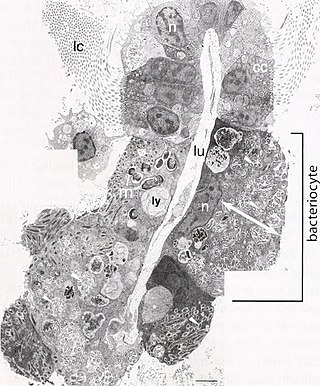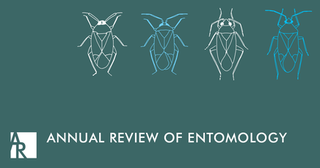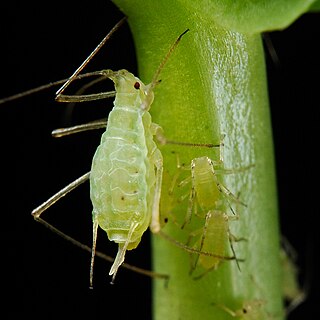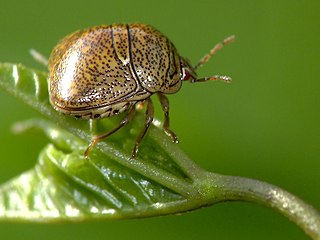Related Research Articles

An endosymbiont or endobiont is any organism that lives within the body or cells of another organism most often, though not always, in a mutualistic relationship. (The term endosymbiosis is from the Greek: ἔνδον endon "within", σύν syn "together" and βίωσις biosis "living".) Examples are nitrogen-fixing bacteria, which live in the root nodules of legumes, single-cell algae inside reef-building corals and bacterial endosymbionts that provide essential nutrients to insects.

Insecticides are pesticides used to kill insects. They include ovicides and larvicides used against insect eggs and larvae, respectively. Insecticides are used in agriculture, medicine, industry and by consumers. Insecticides are claimed to be a major factor behind the increase in the 20th-century's agricultural productivity. Nearly all insecticides have the potential to significantly alter ecosystems; many are toxic to humans and/or animals; some become concentrated as they spread along the food chain.

Aphids are small sap-sucking insects and members of the superfamily Aphidoidea. Common names include greenfly and blackfly, although individuals within a species can vary widely in color. The group includes the fluffy white woolly aphids. A typical life cycle involves flightless females giving live birth to female nymphs—who may also be already pregnant, an adaptation scientists call telescoping generations—without the involvement of males. Maturing rapidly, females breed profusely so that the number of these insects multiplies quickly. Winged females may develop later in the season, allowing the insects to colonize new plants. In temperate regions, a phase of sexual reproduction occurs in the autumn, with the insects often overwintering as eggs.

Hemiptera is an order of insects, commonly called true bugs, comprising over 80,000 species within groups such as the cicadas, aphids, planthoppers, leafhoppers, assassin bugs, bed bugs, and shield bugs. They range in size from 1 mm (0.04 in) to around 15 cm (6 in), and share a common arrangement of piercing-sucking mouthparts. The name "true bugs" is often limited to the suborder Heteroptera.

Buchnera aphidicola, a member of the Pseudomonadota and the only species in the genus Buchnera, is the primary endosymbiont of aphids, and has been studied in the pea aphid, Acyrthosiphon pisum. Buchnera is believed to have had a free-living, Gram-negative ancestor similar to a modern Enterobacterales, such as Escherichia coli. Buchnera is 3 µm in diameter and has some of the key characteristics of its Enterobacterales relatives, such as a Gram-negative cell wall. However, unlike most other Gram-negative bacteria, Buchnera lacks the genes to produce lipopolysaccharides for its outer membrane. The long association with aphids and the limitation of crossover events due to strictly vertical transmission has seen the deletion of genes required for anaerobic respiration, the synthesis of amino sugars, fatty acids, phospholipids, and complex carbohydrates. This has resulted not only in one of the smallest known genomes of any living organism, but also one of the most genetically stable.

A bacteriocyte, also known as a mycetocyte, is a specialized adipocyte found primarily in certain insect groups such as aphids, tsetse flies, German cockroaches, weevils. These cells contain endosymbiotic organisms such as bacteria and fungi, which provide essential amino acids and other chemicals to their host. Bacteriocytes may aggregate into a specialized organ called the bacteriome.
Annual Reviews is an independent, non-profit academic publishing company based in San Mateo, California. As of 2021, it publishes 51 journals of review articles and Knowable Magazine, covering the fields of life, biomedical, physical, and social sciences. Review articles are usually “peer-invited” solicited submissions, often planned one to two years in advance, which go through a peer-review process. The organizational structure has three levels: a volunteer board of directors, editorial committees of experts for each journal, and paid employees.

May Roberta Berenbaum is an American entomologist whose research focuses on the chemical interactions between herbivorous insects and their host plants, and the implications of these interactions on the organization of natural communities and the evolution of species. She is particularly interested in nectar, plant phytochemicals, honey and bees, and her research has important implications for beekeeping.

Annual Review of Biochemistry is an annual peer-reviewed scientific journal published by Annual Reviews, a nonprofit scientific publisher. Its first volume was published in 1932, and its founding editor was J. Murray Luck. The current editor is Roger D. Kornberg. The journal focuses on molecular biology and biological chemistry review articles. As of 2023, Journal Citation Reports gives the journal an impact factor of 16.6, ranking it seventh out of 285 journals in the category "Biochemistry and Molecular Biology". As of 2023, it is being published as open access, under the Subscribe to Open model.

The Annual Review of Entomology is a peer-reviewed academic journal that publishes review articles about entomology, the study of insects. First published in 1956 from a collaboration between the Entomological Society of America and Annual Reviews, its longest-serving editors are Thomas E. Mittler (1967–1997) and May Berenbaum (1998–2018). As of 2023, Annual Review of Entomology is being published as open access, under the Subscribe to Open model. As of 2023, Journal Citation Reports gives the journal a 2022 impact factor of 23.8, ranking it first of 100 journals in the category "Entomology".

The Annual Review of Physiology is a peer-reviewed academic journal that publishes review articles about physiology. First published in 1939 through a collaboration between the American Physiological Society and Annual Reviews, it was published solely by Annual Reviews after 1962. It covers various aspects of physiology, including cardiac, renal, respiratory, and gastrointestinal physiology, among other subfields. As of 2023, Annual Review of Physiology is being published as open access, under the Subscribe to Open model.As of 2023, Journal Citation Reports lists the journal's 2022 impact factor as 18.2, ranking it second of 79 journal titles in the category "Physiology".

Acyrthosiphon pisum, commonly known as the pea aphid, is a sap-sucking insect in the family Aphididae. It feeds on several species of legumes worldwide, including forage crops, such as pea, clover, alfalfa, and broad bean, and ranks among the aphid species of major agronomical importance. The pea aphid is a model organism for biological study whose genome has been sequenced and annotated.

Megacopta cribraria, also called the bean plataspid, kudzu bug, globular stink bug and lablab bug, is a shield bug native to India and China, where it is an agricultural pest of lablab beans and other legumes. The bug, while harmless to houseplants and people, often enters houses. It is attracted to white surfaces such as the walls of houses or white vehicles, because of the high reflectance of the white surfaces as it relates to the bugs' simple eyes. As a defense mechanism, they emit a foul-smelling pheromone that also acts as a congregation pheromone. Aside from smelling foul, the liquid also creates a burning sensation and sometimes leaves a red welt on bare skin. It is similar to other Plataspidae in having a somewhat unusual symbiotic relationship with its gut bacteria. Before laying eggs, females deposit particles containing the symbiont, which are then eaten by newly hatched nymphs under natural conditions. Nymphs experimentally deprived of access to the symbiont exhibited slower growth, smaller body sizes and higher mortality.
Nasuia deltocephalinicola was reported in 2013 to have the smallest genome of all bacteria, with 112,091 nucleotides. For comparison, the human genome has 3.2 billion nucleotides. The second smallest genome, from bacteria Tremblaya princeps, has 139,000 nucleotides. While N. deltocephalinicola has the smallest number of nucleotides, it has more protein-coding genes (137) than some bacteria.
Lynn Moorhead Riddiford is an American entomologist and developmental biologist. She was the first female faculty member in the Harvard Biology Department where she served as an assistant and associate professor. She is an emeritus professor at the University of Washington. In 1997, she was the first awardee of the Recognition Award in Insect Physiology, Biochemistry, and Toxicology from the Entomological Society of America. Riddiford studies the endocrinology of insects, specifically the tobacco hornworm.
Mariana Federica Wolfner is the Goldwin Smith Professor of molecular biology and genetics at Cornell University. Her research investigates sexual conflict in the fruit fly Drosophila melanogaster. She was elected a member of the National Academy of Sciences (NAS) in 2019 in recognition of her distinguished and continuing achievements in original research.

Nancy Elizabeth Beckage was an American entomologist known for her work on host–parasitoid interactions. She held professorships in entomology and in cell biology and neuroscience at the University of California, Riverside.
Diana L. Six is a forest entomologist and professor at the University of Montana. Her research focuses primarily on bark beetle ecology and forest adaptation to climate change. Six is the recipient of the 2018 Edward O. Wilson Biodiversity Technology Pioneer Award, has presented at TEDx, and has been featured in National Geographic among other nationally recognized media.
Thomas Eduard Mittler was an Austrian entomologist who primarily researched the diets of insects, particularly aphids. He was the editor of the Annual Review of Entomology from 1967–1997.
Nicole M. Gerardo is an entomologist and Professor of Biology at Emory University in Atlanta, Georgia. In 2021, she became editor of the Annual Review of Entomology.
References
- 1 2 3 "Front matter" (PDF), The Insects: Structure and Function (5th ed.), Cambridge University Press, 2013, ISBN 978-0-521-11389-2, archived (PDF) from the original on 29 March 2018, retrieved 3 June 2019
- 1 2 3 4 5 6 7 Angela E. Douglas, ESA Fellow (2011), Entomological Society of America, July 2011, archived from the original on 16 December 2019, retrieved 1 June 2019
- 1 2 3 Angela E Douglas: Curriculum Vitae (PDF), Cornell University, August 2018, archived (PDF) from the original on 3 June 2019, retrieved 1 June 2019
- 1 2 Angela Douglas honoured with Karl August Möbius Fellowship 2017, Kiel University, 2 May 2017, archived from the original on 3 June 2019, retrieved 3 June 2019
- ↑ Publications, Cornell University, 16 May 2019, archived from the original on 5 June 2019, retrieved 1 June 2019
- ↑ Angela E. Douglas, Cornell University, 2018, archived from the original on 5 June 2019, retrieved 1 June 2019
- ↑ Winners of the Recognition Award in Insect Physiology, Biochemistry, and Toxicology, Entomological Society of America, archived from the original on 16 December 2019, retrieved 3 June 2019
- ↑ Angela E. Douglas (2019), "Preface", Annual Review of Entomology , 64: v–vi, doi: 10.1146/annurev-en-64-103018-100001 , PMID 30629891
- ↑ Jon Harrison (2021), "Preface", Annual Review of Entomology , 66: v–vi, doi: 10.1146/annurev-en-66-111120-100001 , PMID 33417817